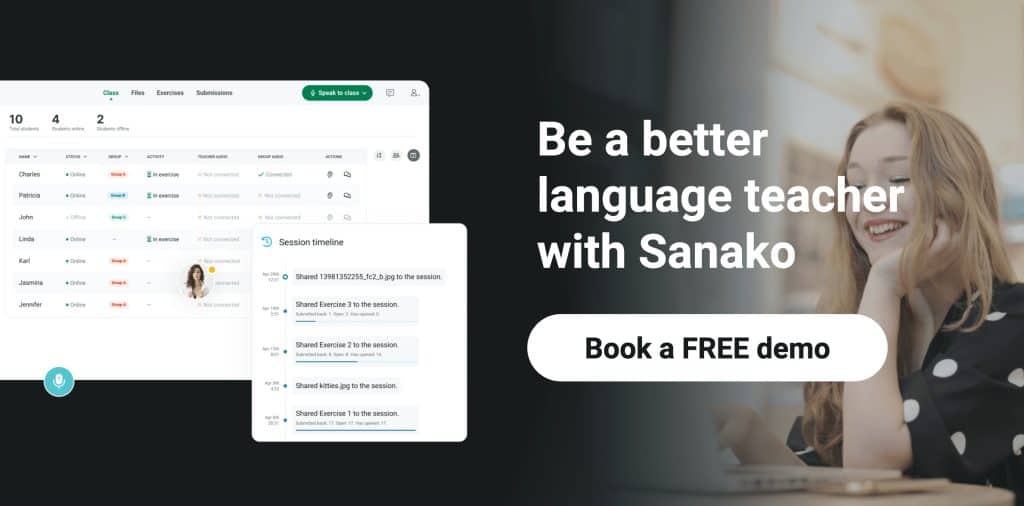Perhaps the most common public misconception about language learning is that it’s still dominated by passive learning experiences – where students absorb information primarily through lectures by the teacher and through rote memorization techniques. Yet in recent years, there’s been a notable shift towards flipped learning, a pedagogical approach that has revolutionised the way language is taught and learned.
We’ve already written a detailed blog post about the benefits of the flipped classroom for language learning, so this blog post will specifically look at four ways in which the flipped learning approach can unlock students’ L2 fluency. We’ll also include some practical ideas of implementing them in your language classrooms.
But before we get into that, let’s quickly review the key principles behind the flipped learning approach.
What is flipped learning?
Also known as the inverted classroom, flipped learning turns the traditional learning process on its head. Instead of relying on in-class lectures to introduce new concepts, flipped learning sees the teacher assign pre-class activities (such as reviewing video content, completing online activities or reading prescribed texts), allowing learners to independently explore and engage with the subject at their own pace and convenience.
During classroom sessions, the focus shifts from passive instruction to active engagement, with teachers facilitating discussions, conducting group activities and providing individualised feedback. This shift in responsibility puts students in charge of their learning, empowering them to build a deeper understanding and engagement with the language.
1. Building student engagement: sparking curiosity and motivation
Flipped learning transforms the traditional passive learning experience into a more active, student-centred approach. This piques student curiosity, igniting motivation and fostering a deeper engagement with the language.
- Tailoring pre-class activities: Create a variety of pre-class materials to cater to different learning preferences and student circumstances. As above, this could include engaging videos, reviewing key vocabulary items, interactive quizzes, self-paced exercises and online discussions. This approach ensures that every learner finds a way to connect with learning material on a personal level, thereby maximising their engagement.
- Incorporating technology: Technology can play a key role enhancing the pre-class experience. At the most basic level, students need to be able to easily access resources through a language learning platform, like Sanako Connect. Encourage them to use apps, interactive games and multimedia content as part of a more immersive and engaging learning environment.
2. Controlled practice: building a solid foundation
This transformative approach also provides ample opportunities for learners to practise and solidify their understanding of grammar, vocabulary, and pronunciation, ensuring a strong foundation for language mastery. Rather than just relying solely on in-class activities, such controlled practice opportunities build confidence in learners, helping them to use the language with greater fluency and accuracy.
- Creating structured practice activities: Focus pre-class exercises and activities on controlled practice of grammar rules, vocabulary building and pronunciation drills. This helps learners internalise key language structures and improve their fluency. Encouraging practice at home also helps to reduce students’ nervousness and builds confidence.
- Integrating collaborative practice opportunities: Encourage peer interaction and collaboration through online forums, group projects, and role-plays. This fosters a supportive learning environment where learners can practise their language skills together, providing feedback and learning from each other.
- Use technology for practice and feedback: Sanako Connect and its associated pronunciation practice tools can also provide personalised feedback and access to practice exercises. These enhance the effectiveness of controlled practice and reinforce learning outcomes.
3. Developing fluency by embracing authentic communication
Modern language teaching aims to bridge the gap between theoretical knowledge and practical application. Flipped learning helps immerse learners in authentic communication scenarios – these foster learners’ fluency by using their language skills in meaningful, real-world contexts
- Simulations and role-plays: Create realistic simulations and role-play activities that encourage learners to use the target language in meaningful contexts, such as business meetings, social interactions or topic presentations. These provide a platform for building fluency and enhancing communication skills.
- Guest speakers and storytellers: Invite native speakers, language experts or storytellers to share their experiences and engage in authentic conversations with learners. This exposure to native language usage and cultural nuance helps improve fluency and cultural understanding.
- Authentic communication outside the classroom: Encourage learners to engage in L2 conversation with native speakers or language partners online or in their communities. This immersion in real-world communication builds confidence and prepares learners for practical language use.
4. The path to long-term language mastery
Typically, flipped learning is characterised by cyclical activities and reinforcement techniques. These allow learners to revisit concepts, reinforce learning and refine their language skills over time, promoting long-term mastery.
This approach also ensures that language acquisition becomes an ongoing process, not a one-time event. And by making key resources available to them outside of the classroom, students can more easily access learning opportunities wherever and whenever they need them.
- Regular review: Schedule frequent catch-up sessions and opportunities for learners to practise and refine their language skills. This cyclical approach reinforces understanding and helps learners retain knowledge over time. These sessions can also be used to check in with students – use them to make sure that they are able to access the available resources and ask if they have a space for quiet practice etc.
- Language learning platforms: Employ language learning platforms (such as Sanako Connect) to personalise instruction based on individual learner’s needs and their progress. This allows learners (and educators) to focus on areas that require further development, promoting long-term mastery.
- Self-directed learning: Encourage learners to take ownership of their learning journey by exploring topics of personal interest and by conducting independent research. This helps build a lifelong love of language learning and promotes sustained engagement.
How can Sanako Connect help you deliver a flipped classroom approach?
A robust, multi-functional language learning platform can be a language teaching game-changer. Sanako Connect, for example, combines all of the best bits of a physical language lab with the essential elements of a virtual classroom environment and dedicated language learning apps.
Importantly, the Sanako Connect platform makes it easy for teachers to upload a wide variety of learning material for students to use pre-class. Any number of PDFs, presentations, YouTube videos, and web pages can, for example, be easily attached to an online lesson plan and shared with students. Connect also allows educators to embed external source code, enabling them to access and use third-party apps within the Connect environment (eg. Quizlet, Google Docs, Slides, etc.).
Educators can also use Connect to create tasks for students based on these materials. These include, for example, pronunciation tasks with automated grading, live group discussion and role-play activities, digital flashcards, model imitation, video tasks, oral language assessments or fill-in-the-blanks tasks for students. Such activities can be created by educators in minutes and then easily accessed and used by students, wherever they are.
Finally, Sanako Connect has been specifically developed to help educators maximise opportunities for collaborative working and speaking practice. Learners could be tasked to record themselves reading aloud or responding to a pre-prepared piece of content. Alternatively, educators can create an original soundtrack, which the student then attempts to emulate using Sanako Connect’s advanced, two-track recording functionality. Voice and text feedback mechanisms help educators to provide rapid, targeted feedback to individuals or groups of students.
Sanako Connect is designed to offer and support total pedagogical flexibility. The flipped classroom approach is just one teaching style that we support. Click here or the banner below to learn more and to book a FREE remote demo!

